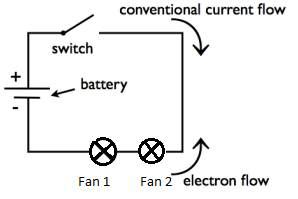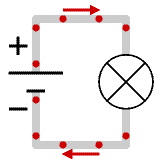Batteries are the power source of many circuits and provide the electricity that flows through a circuit.
They have a negative and positive terminal on each end. The electricity exits the positive (labeled) terminal of a battery and returns back to the negative (labeled) terminal.
In reality, the electricity is flowing from the negative terminal to the positive terminal due to the negative charge of electrons.
To understand the wrong labeling on batteries, one must first know the difference between conventional and electric current.
Electric current is the way that electricity actually flows. (Negative to positive.)

Source: wikimedia.org
Conventional current is the way that Benjamin Franklin mistakenly thought that electricity flowed. (Positive to negative.)

Source: dlb.sa.edu.au
Conventional current is commonly used in circuit diagrams and symbols, despite the inaccuracy.
This would also explain why the terminal from which electricity flows is labeled “Positive” instead of “Negative.”
This confusing labeling is very important when creating circuits.
One must keep in mind that the positive side provides power and flows back to the negative side, or ground (GND), while connecting a battery to different parts.
This is the schematic symbol of a battery:

Source: sites.google.com




